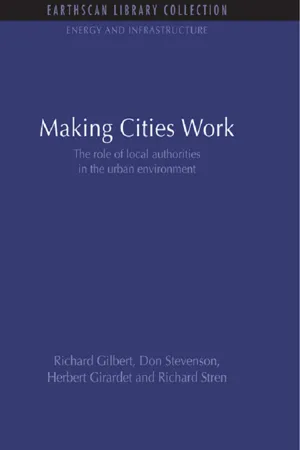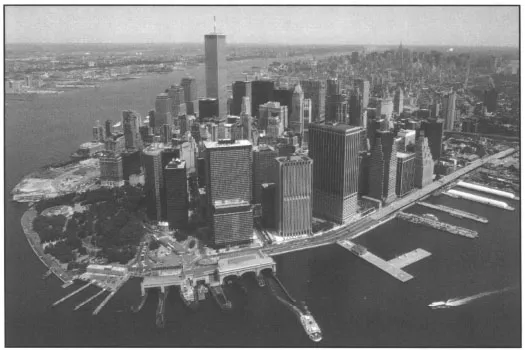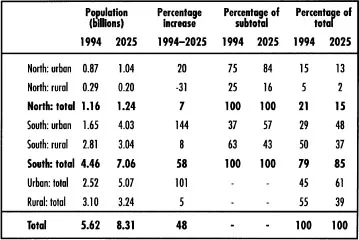![]()
PART 1
Street Scene, Bangladesh
![]()
CHAPTER 1
Local Authorities and
the Environment
Manhatten Island, New York
Introduction
The 20th century will be remembered for many things – devastating wars, remarkable technological change, the human population explosion, environmental degradation – but perhaps above all for the dramatic urbanization of human societies. At the beginning of the present century about 150 million people lived in cities and towns – less than one in ten of what was then the world’s population; by the end of this century this figure will have increased twenty-fold, amounting to half the world’s population. In 1900, only five or six urban regions had more than a million people. By 2010, a similar number will each have a population of more than 20 million. In the unfolding of human experience the 20th century will have been the bridge between the last rural century and the first urban century.
The cities and towns of the world often seem unmanageable. In reality, their governments are often among the most sophisticated examples of human ingenuity and organizational ability, thanks to the dedication of generations of municipal officials and others concerned with the health of cities. But there are strains everywhere, on account of global and local trends that have their strongest impacts in urban areas. Prominent among these trends are those concerning the environment.
Making Cities Work is about urban settlements and the environment, and the role of local governments in ensuring well-functioning cities and in making progress towards sustainable development. The book has three main aims:
1 To make the case that local governments should play, and in many cases are playing, central roles in designing and implementing programmes to ensure healthy environments.
2 To illustrate – particularly for the benefit of central governments and international bodies – practical measures that cities around the world have taken to protect and enhance the local and global environment.
3 To show how local authorities can be supported by other governments and agencies and, through cooperation between themselves, do more in pursuit of sustainable development.
This opening chapter provides the context for the rest of the book. It defines relevant terms and concepts, and notes the great demographic, economic, and technological transformations that confront the world’s local authorities. It touches on the environmental challenges faced by those responsible for the governance of urban areas and on the advantages of cities for sustainable development. It deals with the importance of good governance to local action in support of sustainable development. It describes the worldwide trend towards devolving responsibility for dealing with urban issues to local government. Based on this context, Chapter 2 will set out the issues for local action as seen by local authorities themselves.
Cities, Towns and Local Authorities:
Urban and Suburban
The focus in this book is on cities and local authorities. The term city (or town) is used here as a synonym for urban settlement. It covers an extraordinarily wide range of sizes and circumstances, including huge agglomerations-sometimes known as megacities – and small market towns. It embraces wealthy cities and poor cities, cities with stable or declining populations, and cities that are growing at a furious rate.
The term local authority (or local government) refers to general-purpose governing arrangements for human settlements, including two-tier, regional-local arrangements where they exist. The governing councils of local authorities are usually elected by popular suffrage, but in some cases they are appointed by senior governments. This book is more about local authorities and their work on environmental issues than it is about the cities for which they are responsible. Many non-urban areas are governed by local authorities, but this book does not focus on their numerous issues.
In this book, the term urban includes what is usually meant by suburban, unless a specific distinction is made. In the past, the difference between urban and non-urban was much clearer. Cities were tight agglomerations of buildings; rural was where the buildings stopped. If you fly over small towns in Germany even now, you see sharp boundaries between urban and rural – a consequence of tough legislation preventing the conversion of urban land.
Box 1.1
The Distribution of the World’s Total, Rural and Urban Populations and its Largest Cities, 1990
Source: David Satterthwaite, An Urbanising World: The Second Global Report on Human Settlements (1996), Oxford University Press, Oxford.
But the notion of a suburb-land or settlements immediately outside a town or city – is very old. Suburbia is a Latin word. Geoffrey Chaucer used ‘suburbes’ in The Canterbury Tales, written around 1386. Then and for hundreds of years after, the slums were in the suburbs, often outside a wall-with holes and corners and blind alleys, Chaucer wrote, where thieves and robbers hid.
Now, suburbs sprawling away from central cities are a feature of many urban regions, particularly in North America but increasingly in Europe and in countries of the South. Suburbs blur the distinction between urban and rural. In Asia, suburbs are often places of intensive cultivation of land;1 elsewhere suburban residents tend to have more urban occupations. In North America, the suburban parts of extended urban regions are usually refuges of the more affluent, extraordinarily dependent on their automobiles, who may work in central cities but live far away from them and their concentrations of poverty and deprivation. In other parts of the world, the suburbs are more likely to be the home of the poorest people in society, often living in shanty towns at the urban periphery with inadequate services and economic opportunities.
Urban residents can be distinguished from rural residents by the size and density of the settlements they live in and by their relative dependence on the formal provision of services. Urban residents tend to rely on established providers in the public or private sector to meet their daily needs-food, clothing, shelter, medical care, recreation – usually through the medium of a cash economy. Rural residents are more likely to meet their daily needs without recourse to institutional or corporate providers of goods and services, often outside a cash economy.
Box 1.2
Urban and Rural Populations of the North and South, 1994, and Projections for 2025
Source: World Urbanization Prospects: The 1994 Revision (1995), UN, New York. Here, North and South refer respectively to the UN designations of ‘more developed regions’ and ‘less developed regions’.
However, what may seem more like a rural way of living can be found within cities, especially in the South, and the ways of living of rural residents of the North can often barely be distinguished from those of their urban counterparts. The distinctions between urban and rural are dissolving, especially with improved communications. The distinctions are becoming especially strained with the growth of affluent suburbs in the North (and even in the South), where the dependence on formally provided services is as great as in urban areas but residential densities are closer to those found in rural areas.
Box 1.3
Urban Farming Throughout the World
Singapore is fully self-reliant in meat. Singapore also produces 25% of the vegetables its people consume…Bamako, Mali, is reported to be self-sufficient in vegetables and to produce half or more of the chickens it consumes… Dar-es-Salaam has been among the fastest growing large cities in the world…. From 1967 to 1991, the proportion of families in the city engaged in farming rose from 18 to 67%… There are 80,000 community gardeners on municipal land in Berlin with a waiting list of 16,000… The shift in just 20 years in the number of Moscow families engaged in food production – from 20% in 1970 to 65% in 1991 is remarkable…. The 1980 US census found that urban metropolitan areas produced 30% of the dollar value of US agricultural production. By 1990, it had increased to 40%.
Source: Urban Agriculture: Food, Jobs and Sustainable Cities (1996), UNDP, New York.
The First Urban Century
When the 20th century began, less than 10 per cent of the world’s population lived in urban settlements. When the century ends, close to half of the world will live in cities and towns. The process of urbanization is likely to continue for several decades. The 21st century will thus be the first urban century: the first such period in which the majority of humanity will have an urban (or suburban) existence.
As Box 1.2 shows, most of the growth in population expected in the early part of the next century will be growth in the urbanized population of the South, which is expected to increase by almost two-and-a-half times between 1994 and 2025. This increase will be the result of the continuation of two profoundly important trends: the overall growth in the population of the South and the continued urbanization of the South. Indeed, Box 1.2 suggests that soon after 2025 more than half the world will be living in urban settlements in the South.
But the phenomena of urbanization in the South vary markedly from country to country and from place to place. In every area, internal growth is an important factor in the growing size of urban settlements. In most areas, migration from rural areas is also important. Mention has already been made of the intensive agriculture practised within the urban regions of many Asian countries. There, urban regions grew mainly by urbanizing, in situ, relatively densely populated rural areas at the edges of the cities. Their residents became urban when they began to enjoy some urban services and amenities, although on some counts they are still regarded as rural. In other places, the urbanization of the population is mostly a process of migration from rural to urban regions.
Variations in the degree of urbanization of selected countries in the North and the South are evident in Box 1.4, which shows that some of the countries of the South, particularly in Latin America, are as urbanized as countries of the North.
The conditions of urbanization, however, may be very different between North and South, chiefly on account of the higher quality of the services available to residents of cities in the North. These services include ‘hard’ services such as effective sanitation, accessible drinking water, and good public transport, ‘soft’ services such as education and health care, and protective and emergency services such police, fire, pollution control, and ambulances. The differences exist in part because of the greater affluence of the North but they can also be due to cultural, political, and managerial differences, as the wide variations among service levels in the North indicate.
Levels of urbanization can be difficult to compare because of differences in definitions of urbanization. In Japan, settlements with a population of 50,000 or more (and some other settlements defined by the prefectural governments) are counted as urban. Portugal and Switzerland include only settlements with at least 10,000 inhabitants. Australia, the UK and Venezuela routinely count settlements with as few as 1,000 inhabitants as urban. Argentina and Ethiopia draw the line at 2,000 inhabitants. India and the Philippines rely as much (or more) on the density of settlements as the criterion of urbanity as on the number of people in a settlement. In Indonesia and South Africa, a settlement is classified as urban if it has urban characteristics. In Belgium, Brazil, China, Hungary and Trinidad and Tobago, a settlement is considered urban if it has a certain kind of governmental structure (which may beg the question as to why it has such a structure). Because of such differences in definition, comparisons between countries should be made with caution.2
Box 1.4
Urban Population as a Percentage of the Total Population: Selected Countries in the North and South (1994)
Source: World Urbanization Prospects: The 1994Revision (1995), UN, New York.
The rapid urbanization of recent years has posed huge challenges for public administration. Growth h...






